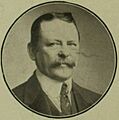City of London (UK Parliament constituency) facts for kids
Quick facts for kids {{{Name}}}[[{{{Type}}} constituency]] |
|
|---|---|
| [[Image:{{{Map1}}}Constituency.svg|120px|]] [[Image:England{{{Map2}}}.svg|120px|]] |
|
| {{{Name}}} shown within [[{{{Entity}}}]], and {{{Entity}}} shown within England | |
| Created: | {{{Year}}} |
| MP: | {{{MP}}} |
| Party: | {{{Party}}} |
| Type: | House of Commons |
| County: | [[{{{County}}}]] |
| EP constituency: | [[{{{EP}}} (European Parliament constituency)|{{{EP}}}]] |
The City of London was a special area in the United Kingdom that used to elect people to the UK Parliament. It was like a voting district, sending representatives to the House of Commons. This happened from 1707 to 1800 for the Parliament of Great Britain, and then from 1801 to 1950 for the Parliament of the United Kingdom.
Contents
What was the City of London Constituency?
This special voting area was exactly the same as the actual City of London. This is the very old, central part of Greater London. The only small change was in 1832, when an area called The Temple was included.
The City of London is bordered by the River Thames to the south. To the west, it touches Westminster, which also elected its own representatives. For a long time, the City of London had its own special rules and government, separate from the areas around it.
How the City of London Got Its Voice in Parliament
London first started sending people to Parliament in 1298. Because it was the most important city in England, it was given four seats in Parliament. Most other areas only had two. Before 1298, people in the City of London were represented by two "knights of the shire" from Middlesex. Even though the City was part of Middlesex, it had its own independent government.
The City of London kept its four Members of Parliament (MPs) until 1885. Then, this number was cut down to two. Finally, in 1950, the special voting district of the City of London was ended.
Who Could Vote in the City of London?
The City of London was once a very busy and crowded place. Before 1832, the way people voted here was different from other areas. Only members of certain old trade groups, called Livery Companies, had the right to vote. However, because the City was so important and wealthy, it still had many more voters than most other areas. In the late 1700s, there were about 7,000 voters, which was a lot for that time. Only Westminster had more.
Over time, London grew much larger, but the number of people actually living in the City of London itself started to shrink. People moved to new neighborhoods and suburbs, and businesses moved into the City. But the City's leaders wanted to keep its traditional "square mile" boundaries. This meant that even though fewer people lived there, the voting district stayed the same. By 1900, most voters in the City qualified to vote because they were part of a Livery Company, even if they lived outside the City.
These "business voters" sometimes had more than one vote if they owned property in different places. When this "plural voting" was stopped in 1948, the City of London suddenly had very few voters for its number of representatives. It became similar to the old "rotten and pocket boroughs" from before 1832, which were unfair voting areas with very few voters.
In 1950, the City of London's voting district was combined with parts of the nearby City of Westminster. Together, they formed a new voting area called Cities of London and Westminster. For a while, there was a law that said the City of London must always be part of its own voting district.
Members of Parliament (MPs) for the City of London
The City of London sent many important people to Parliament over the centuries. From 1707 to 1885, it had four MPs. After 1885, it had two MPs until 1950. These representatives came from different political groups, like the Whigs, Tories, Liberals, and Conservatives, as political parties changed over time.
How Elections Worked
When the City of London had more than one MP to elect, they used a system called "bloc voting." This meant voters could cast a vote for as many candidates as there were open seats (for example, up to four votes when there were four seats). The candidates with the most votes won. In 1868, a "limited vote" was introduced, which meant voters could only use a certain number of their votes, even if there were more seats available.
For special elections, called "by-elections," which filled just one empty seat, they used the "first past the post" system. This is where the candidate with the most votes wins, even if they don't get more than half of all the votes.
It's important to remember that political parties in the past, especially before the 1800s, were not as organized as they are today. Sometimes, people didn't even agree on who belonged to which party!
Images for kids
See also
- Duration of English, British and United Kingdom parliaments from 1660
- List of parliamentary constituencies in London
- Cities of London and Westminster (UK Parliament constituency)









